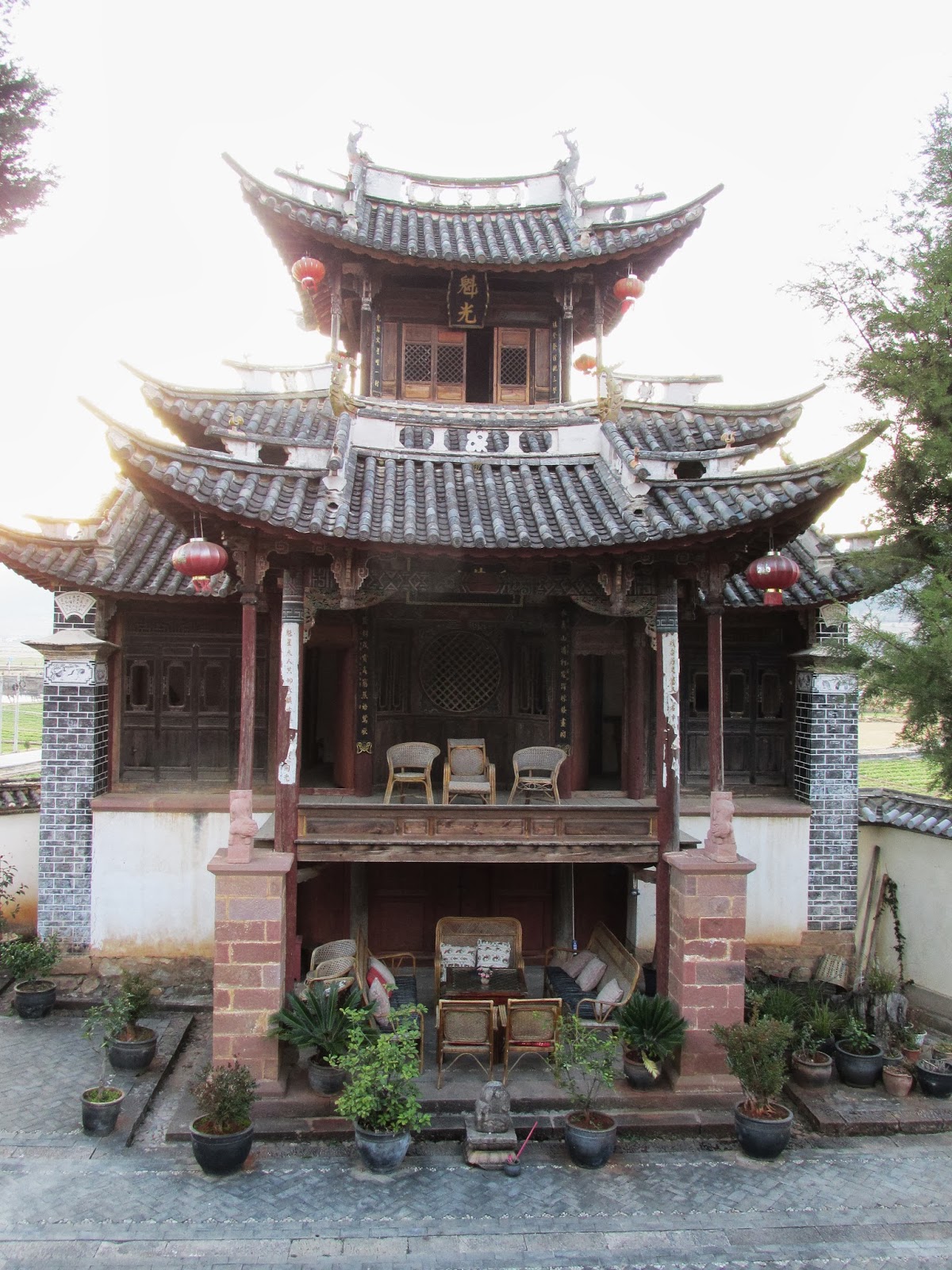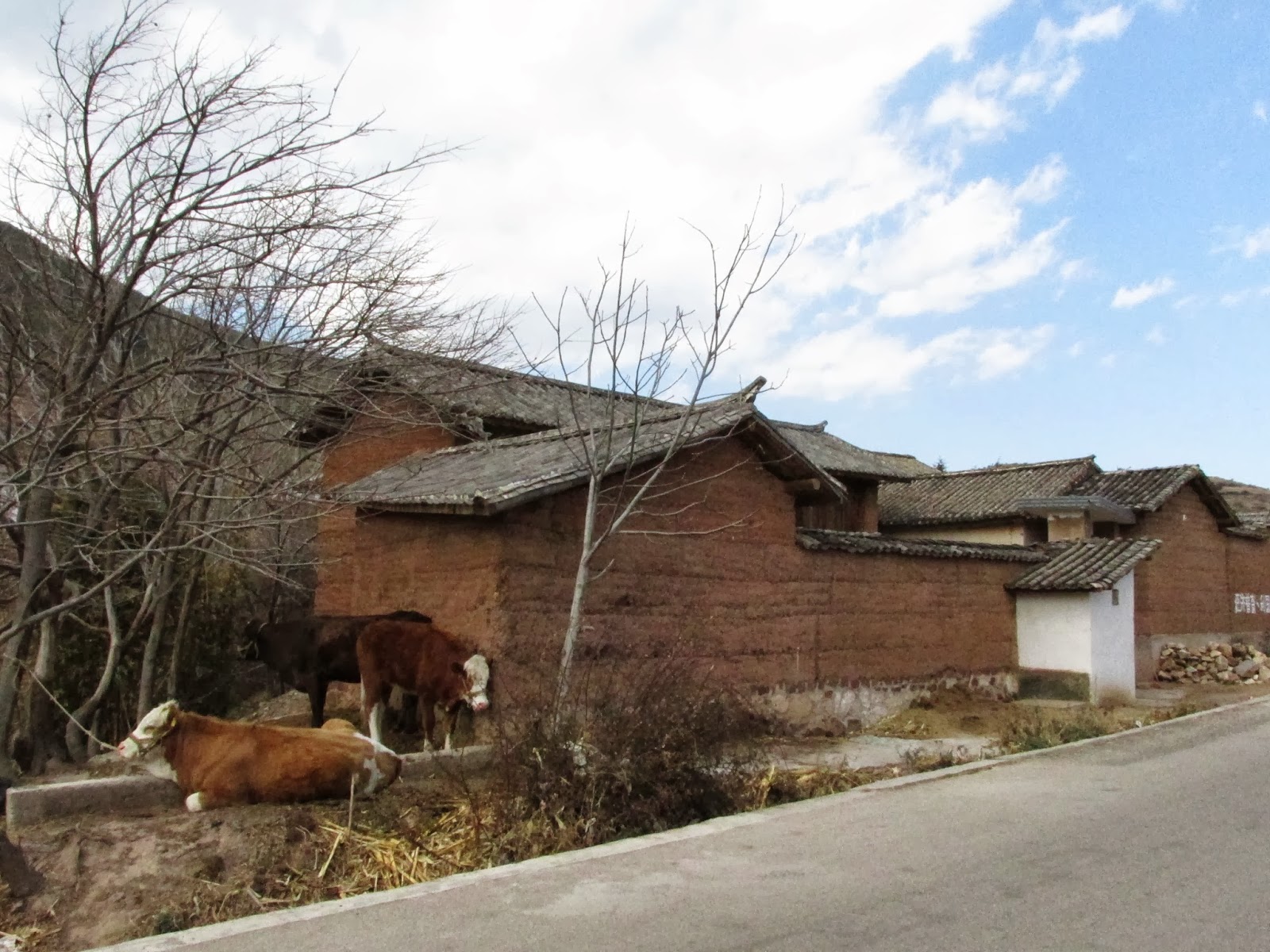When I
arrived back at the guesthouse Wednesday evening, Sammy came to tell me that we
had been invited to a dinner for a new house. The meal included ten dishes,
only one of which was not meat. I hadn’t seen so many meat dishes at one time.
One was chunks of fat.
When we arrived, the men were eating. After they
finished, women sat at some of the tables. After everyone ate, the tables and
benches were quickly removed and the ground was swept.
There were several
people sitting around a fire; so we joined them, as it was chilly. (The woman in the blue jacket is MaoMao's mother.)
MaoMao
said that the house structure had been put up in three hours. There were red
banners on the central posts. She told me that two were upside down. She was
told that this was intentional, as it indicates that good luck is good luck no
matter what direction it comes from. During dinner, we were invited to stay for
dances starting at 8:00. While we waited, we went to Sammy’s house where we met
her father and sister. In talking with him, MaoMao learned that local people
are concerned that the new highway from Lijiang to Jianchuan will change the
village. One tunnel is 3800 meters long. She learned from talking to the man
who carved the wood trimming for the house that young men aren’t interested in
learning this craft; it takes too long to do it, and they want to finish things
quickly. I had heard this in Vietnam, too.
When we
returned to the new house, people were playing cards. We joined the group
sitting around the fire, which was toasty. One man chatted with MaoMao and her mother
a lot. He brought us some hard nougat-like candy that was broken into small
pieces. He showed us how to hold our piece near the fire to soften it enough
that a wooden skewer could be inserted. Then the candy is held over the fire to
make it soft. The soft layer is eaten and then the process is repeated. It was
quite good. The experience was like toasting marshmallows over a campfire. When
the dancers hadn’t returned in an hour and a half, we left. It was a pleasant
and relaxing night.
Thursday
morning we returned to the new house for breakfast. MaoMao had suggested that we contribute cash
in an envelope, which was a good idea. As in Thailand, donations were recorded
in a book at the door. The meal was a repeat of dinner with two different
dishes. As we arrived, we saw many men leaving. When we entered, the women were
eating. Additional good luck banners were on wall at the back of the new
building structure, and a long table was in front of the wall on which food
offerings were being put. We ate and left.
On the
way back to the guesthouse, we went to look at two modern houses MaoMao and
seen and loved. The gate of one was open; so we went in with Sammy calling out
greetings to the owner. The man came out and chatted with them. The house is
beautiful. The central courtyard is a garden, which seems to be the case in the
modern houses I have been able to peek through the gate of. The older houses
use this area for storage. The owner told MaoMao that the house, not including
the land, cost 1,000,000 yuan (about $167,000).
I had
planned for Thursday to be a quiet, relaxing day. I sat on the veranda most of the day reading, enjoying the landscape, and watching the nearby village life go by.
In the afternoon, I took a walk
through the village and a very short way up the mountain behind it. It was a
perfect way to end my stay in Shaxi.
Friday
morning I had breakfast with a couple from Singapore who were at the
guesthouse. They talked about how cold it was in Shaxi. The man commented that
he had read in books about people saying they were cold and now he really
understands what being cold is. There was a little frost on a car that was
still in the shade at 9:30.
After
breakfast I bicycled to Shaxi to go to the Friday market, which is always
mentioned as something to do in Shaxi. The main area was full of venders
selling vegetables and some fruits. People shopping carry baskets on their backs to hold their purchases. There were a few different types of baskets.
 Truckloads of vegetables were brought to
the market. I watched in awe as huge bags and containers of vegetables were
unloaded from a truck and put on women’s backs to be carried into the market
area. I’ve never seen women carrying such heavy loads before, and I wondered
where the men were and why they weren’t carrying the heavy loads.
Truckloads of vegetables were brought to
the market. I watched in awe as huge bags and containers of vegetables were
unloaded from a truck and put on women’s backs to be carried into the market
area. I’ve never seen women carrying such heavy loads before, and I wondered
where the men were and why they weren’t carrying the heavy loads.
In another area I came upon the meat market. Whole
slaughtered animals were on tables in large chunks that were cut as people
bought the meat.
Along the streets people sold small amounts of vegetables and
other items such as hats and dry goods. It was a busy place with people coming
and going. When I left at 11:30, the street was more crowded than when I
arrived at 10:15.
Shaxi
is on the old Tea Horse Road, like the Silk Road but for tea and horses. The
road was used to carry tea across China to other places. Some tea was traded
for Tibetan horses, thus the name. A sculpture at the town’s entrance honors
the horses.
The
area is home to the Bai ethnic/minority group. The old women wear traditional
clothes. Young women do not.
Leaving
Shaxi proved a bit challenging. I hired a taxi to take me to the place where I
could get a van to Jianchuan. When one pulled up, it was immediately filled and
I was left out. To be fair, I’m pretty sure most of those people were waiting
when I arrived. Another man was also left behind, and I thought he looked like
a Chinese tourist. Twenty minutes later another van drove into the lot; so I
followed it. A few people were giving money to the driver. When I tried to give
him my money, he said “no.” When I asked if it was going to Jianchuan, he said
“no.” I walked away and stood at the entrance to the lot, not knowing what to
do next. A few minutes later, he waved me over and motioned for me to get in.
When I asked if he was going to Jianchuan, he nodded and took my money. I was
seated in the back next to the other man. He spoke English fairly well and said
the driver had done the same thing to him. After several minutes, the van
stopped and picked up two more men. One was seated in the back with the
luggage; the other shared the front seat. So we now had 11 passengers in the
7-passenger van. The journey went smoothly.


























































